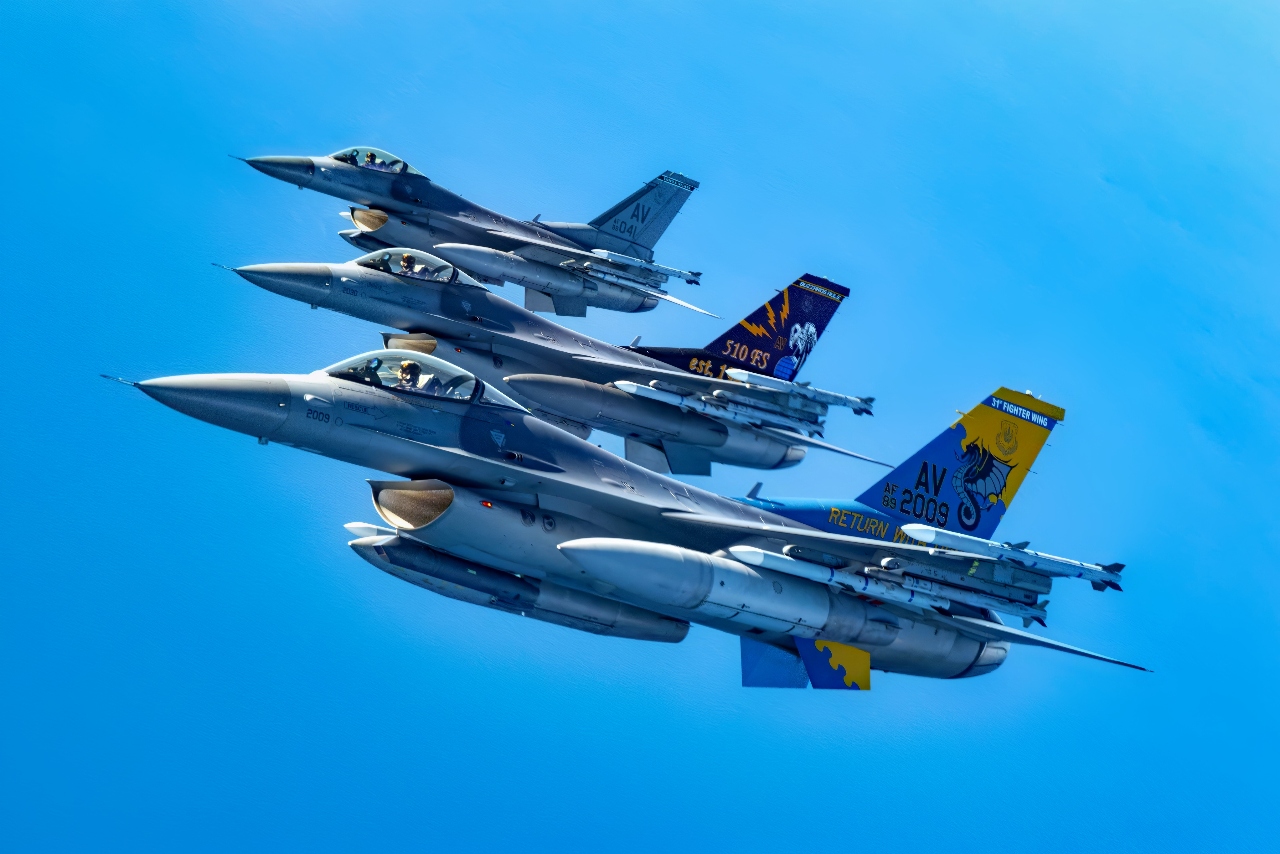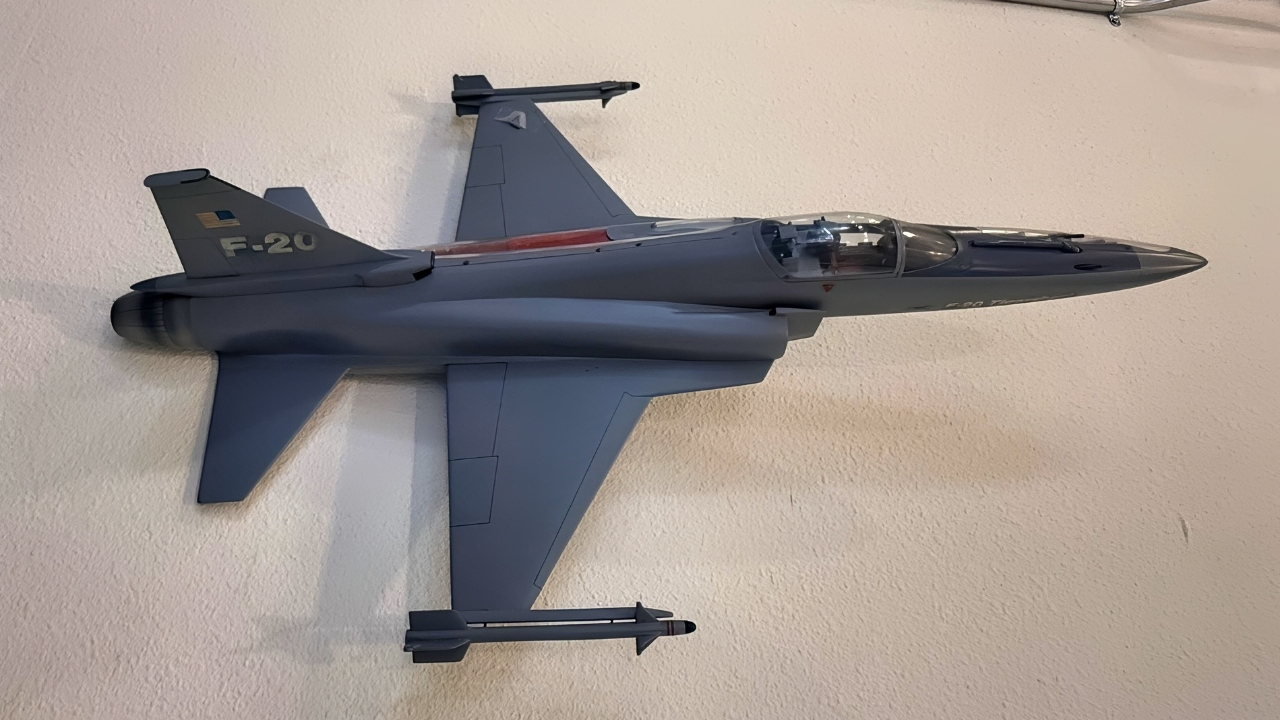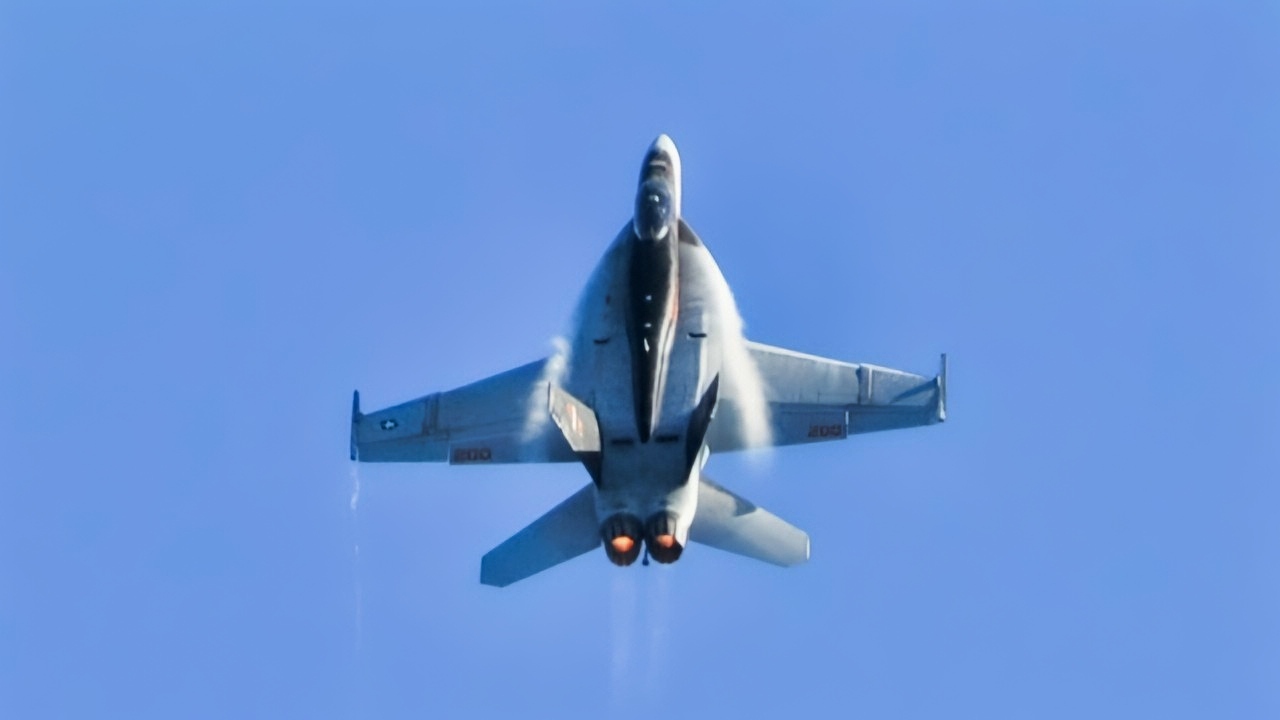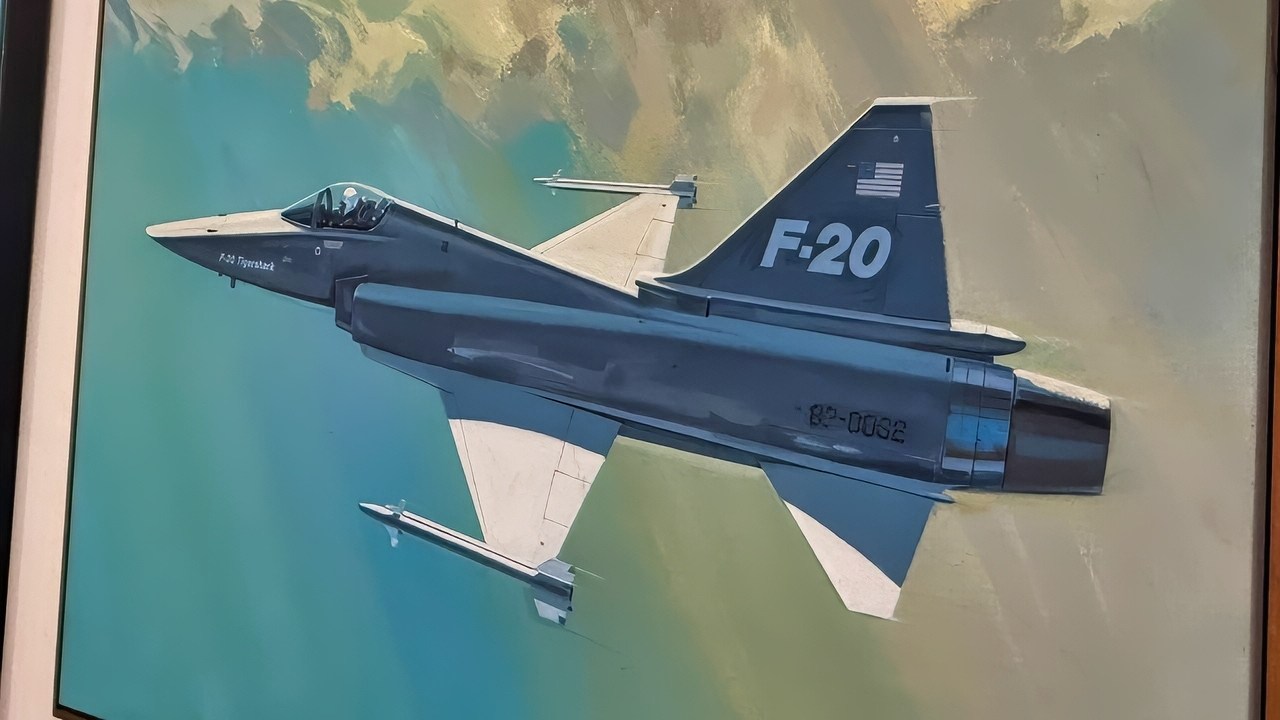F-20 Tigershark: Article Summary
-Northrop’s F-20 Tigershark began as a simple idea: evolve the proven F-5 into a modern, exportable fighter with low costs, quick readiness, and true look-down/shoot-down.

Three F-16 Fighting Falcons from the 31st Fighter Wing fly above Aviano Air Base, Italy, November 21, 2024. The F-16’s enduring appeal lies in its technological relevance, with continual upgrades to avionics, radar systems and weaponry ensuring it remains a formidable force in modern air warfare. (Courtesy photo by Frank Crebas)

F-20 Tigershark Model at Western Museum of Flight. Image Credit: Harry J. Kazianis/National Security Journal Image Taken on August 16, 2025.
-A new radar, a reliable single F404 engine, and digital avionics gave it punch far beyond its modest size.
-Yet it never found a home. U.S. policy shifted to allow allies to buy the F-16, the Air Force refused to be a launch customer, and two fatal prototype crashes undermined confidence and momentum.
-The result was a technically credible jet beaten by politics, timing, and economics. Its lessons still shape how “affordable” fighters are pitched today.
F-20 Tigershark: A Great Idea That Arrived Without a Buyer
Back in August of this year, I stumbled across the painting above while visiting the Western Museum of Flight outside of Los Angeles to see their YF-23 Black Widow II stealth fighter.
Tucked away in a corner, I found a small offering of materials on the failed F-20 Tigershark, and I was able to snap the photo above, a great watercolor of the now-defunct program.
And with that, it inspired me to write a history of the program and the sad facts around it.
Meet the Tigershark
The F-20 Tigershark didn’t spring from nowhere. In the 1970s, two parallel currents defined fighter design.
One was the Lightweight Fighter movement that yielded the F-16—a high-energy dogfighter with modern sensors that the U.S. Air Force would buy in large numbers.
The other was Northrop’s own F-5 lineage, a family of simple, sharp, inexpensive fighters that dozens of U.S. partners could afford and maintain. The F-20 began as a bridge between those currents: keep the F-5’s virtues of cost and simplicity, add the radar, propulsion, and weapons that the 1980s battlefield demanded, and offer partners a credible alternative to buying American front-line types.
That logic fit U.S. export policy at the time: Washington was cautious about sharing its very best. A purpose-built “second-best” that was still modern—exactly the space Northrop targeted—looked like the right business and strategy play.
Inspirations: F-5 Bones, F-16 Energy, F/A-18 Propulsion
If the F-20 had a family portrait, three ancestors would be in it. From the F-5E Tiger II, it took compact size, clean aerodynamics, and a maintenance philosophy friendly to lean squadrons. From the F-16, it borrowed the ethos of a pulse-Doppler radar, beyond-visual-range engagement, and high sortie generation.
From the then-new F/A-18, it took heart: the F404 turbofan that promised strong thrust with commercial-like reliability and quick turn times. The airframe was new rather than a simple re-engine, with structure, systems, and avionics designed around a single, modern engine and the digital boxes that made look-down/shoot-down everyday business.

A U.S. Navy F/A-18E Super Hornet aircraft assigned to Strike Fighter Squadron (VFA) 147 performs maneuvers above the aircraft carrier USS Nimitz (CVN 68) during the departure of Carrier Air Wing (CVW) 11 Dec. 10, 2013, in the Pacific Ocean. CVW-11 fixed wing aircraft flew off the Nimitz to return home after being deployed to the U.S. 5th, 6th and 7th Fleet areas of responsibility. (U.S. Navy photo by Mass Communication Specialist Seaman Apprentice Kelly M. Agee/Released)
The pitch was elegant: F-5 costs with F-16-class situational awareness, wrapped in a jet that could sit alert, start quickly, and launch with minimal ground fuss.
What Northrop Hoped to Achieve
Northrop’s goal was not to dethrone the U.S. Air Force’s front-line fighter. It was to give allied air forces a credible, export-cleared option that balanced capability, survivability, and sustainability.
That meant:
Modern Sensing. A true multi-mode pulse-Doppler radar with look-down/shoot-down so the jet wasn’t blind over clutter.
BVR Credibility. Integration for radar-guided missiles in addition to agile short-range weapons, so pilots could fight on their terms rather than the enemy’s.
Reliability and Sortie Rate. A single, robust engine with fast “alert to airborne” timelines for air policing and quick-reaction alert.
Affordability Over a Lifetime. Purchase price was only half the story; Northrop emphasized maintenance man-hours per flight hour, common parts, and training pipelines that smaller air arms could actually sustain.
In an era when many partners had to choose between dated secondhand jets or unaffordable flagships, the Tigershark promised a sensible middle.
The Airplane Itself: Small Jet, Big Brain
On paper—and in demonstration flights—the F-20 carried a lot of airplane in a compact package. A modern glass cockpit replaced the F-5’s steam gauges. The radar and electronic support suite gave pilots a meaningful picture while staying emission-disciplined. The F404 offered crisp throttle response and economy at cruise. Flight controls and aerodynamics delivered a jet that could point quickly, recover energy fast, and remain stable in the regimes where export pilots would actually fight.
Crucially, the jet was designed for quick starts and high availability. Northrop loved to advertise single-point refueling, easy access panels, and a maintainers’ cockpit below the canopy sills. The company knew its market: a great fighter that’s down for maintenance is not a great fighter.
Salesmanship Without a Sponsor
For all its virtues, the F-20 lacked the one feature customers trust most: a U.S. service roundel. Aircraft with a home service benefit from a virtuous circle—doctrine, training, spares, upgrades, and political assurance that someone else is paying to keep the line hot. Northrop courted partners around the world and flew an aggressive demonstration campaign, but most air chiefs (and their parliaments) read the same tea leaves: the U.S. Air Force was not buying the Tigershark.
That absence mattered twice over. It deprived the F-20 of economies of scale and a stable upgrade road map, and it left potential buyers to defend the choice politically against rivals who could say, with truth, “buy what America flies.”
The Policy Goalposts Moved
The F-20 Tigershark was tailored for a specific export policy environment—one in which Washington limited who could buy front-line American fighters. As the 1980s unfolded, those limits eased. U.S. allies could increasingly purchase the F-16, which came with the weight of a massive production run, U.S. Air Force backing, and an upgrade path guaranteed by numbers. Even air forces initially intrigued by the Tigershark discovered that, with Washington’s blessing, the cost delta between “second-best” and best-in-class was smaller than it looked once life-cycle support and interoperability were factored in.
Northrop’s great niche evaporated not because its airplane got worse—but because its market disappeared.
The Crashes That Froze Momentum
Demonstration programs live on confidence. The Tigershark suffered two fatal prototype crashes a year apart. The investigations were complex, but the public facts were brutally simple: two jets lost, two respected pilots gone, and a news cycle that focused on risk rather than promise. Even if the root causes did not indict the design, they chilled already cautious buyers. Air chiefs who might have asked for another briefing asked for time. Politicians who might have fought for funds chose safer ground. In competitive procurements, “maybe later” is often the same as “no.”
Why It Failed: A Confluence, Not a Single Cause
By the mid-1980s, four forces pinned the F-20 to the mat.
No U.S. Launch Customer. Without a home user, every sale was uphill and every upgrade uncertain.
Policy Whiplash. The export space it targeted narrowed as allies got the green light for F-16s.
Economics of Scale. Competing against a fighter built in large numbers by a service that continued to invest in it is a losing proposition—even if your jet is credible.
Perception and Risk. The crash narrative, fair or not, made cautious buyers more cautious.
None of these, alone, had to be fatal. Together, they were.
The “What If” That Still Tempts
Could a different path have saved the Tigershark?
Perhaps—if the U.S. Air Force had bought a modest number for air defense or aggressor roles, giving the jet the sponsor it needed; if policy had remained restrictive long enough to make a tier-two export fighter attractive; if a string of early buyers had created a momentum that begat more buyers.
It’s not fantasy to imagine a small club of F-20 operators in Asia and the Middle East using the jet for air policing, quick-reaction alert, and as a loyal wingman to heavier fleets.
But history is not written in “ifs.” The F-20’s real legacy lies in what it taught program managers and politicians: market timing and policy alignment can matter as much as aerodynamics.
Lessons For Future “Affordable” Fighters
Every decade, someone promises a modern, inexpensive fighter for export customers who can’t—or won’t—buy the latest flagship. The Tigershark’s story offers three guardrails:
Sponsor First. A domestic launch customer (or a large anchor buyer) isn’t a luxury; it’s the skeleton of the program’s future.
Own the Upgrade Path. Avionics, weapons, and software road maps must be funded and credible at the start. Otherwise buyers see an orphan.
Sell the System, Not Just the Jet. Training, simulators, weapons stockpiles, and sustainment networks win competitions long after flight demos end.
The F-20 wasn’t beaten by technology. It was beaten by context—and by a competitor whose context was unbeatable.
A F-20 Tigershark: Final Appraisal
Northrop set out to build a nimble, reliable fighter that allies could afford and trust. Judged on its engineering aims, the F-20 succeeded.
Judged in the world where policies shift, budgets wobble, and buyers prefer company on the journey, it never had a chance.
The Tigershark remains a reminder that in defense aviation, the best aircraft is the one that arrives with a constituency—and that sometimes the market punishes a good airplane simply for being late to a party it helped plan.
About the Author: Harry J. Kazianis
Harry J. Kazianis (@Grecianformula) is Editor-In-Chief and President of National Security Journal. He was the former Senior Director of National Security Affairs at the Center for the National Interest (CFTNI), a foreign policy think tank founded by Richard Nixon based in Washington, DC. Harry has over a decade of experience in think tanks and national security publishing. His ideas have been published in the NY Times, The Washington Post, The Wall Street Journal, CNN, and many other outlets worldwide. He has held positions at CSIS, the Heritage Foundation, the University of Nottingham, and several other institutions related to national security research and studies. He is the former Executive Editor of the National Interest and the Diplomat. He holds a Master’s degree focusing on international affairs from Harvard University.
More Military
China’s New J-35 vs. America’s F-35: Stealth Is Close. Experience Isn’t.
The B-21 Raider Stealth Bomber ‘Math Problem’ That Needs Solving
J-20 Mighty Dragon vs. the World: 5 Strengths That Make China’s Stealth Jet a Problem
U.S. Navy Nimitz-Class Aircraft Carrier: 5 Biggest Complaints
What Makes U.S. Navy Aircraft Carrier USS Harry S. Truman A Powerhouse? 1 Word.










